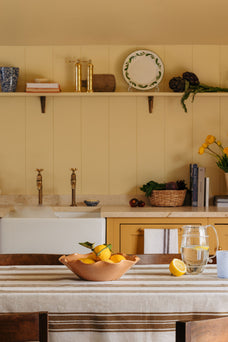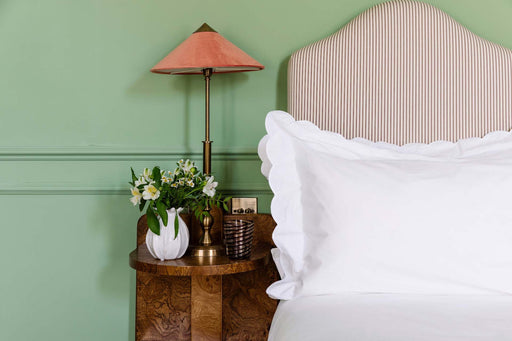Thread count has possibly become a key indicator over time as it is an easier reference point for marketers. It’s important to be aware that higher thread count doesn’t automatically mean better sheets – a little like a higher carat diamond not necessarily being better than a smaller one, or a thicker merino wool jumper being deemed better than a finer, cashmere jumper.
For us, the best sheets are ones that support exceptional sleep (there is an amount of personal preference to this, such as choosing sateen or percale weave), have fantastic longevity, are incredibly cosy and luxurious to sleep in, plus are beautiful in design. For bed linen to fulfil this, we take a holistic approach to fine bed linen. In addition to the thread count, we also consider the quality of the cotton fibres themselves (such as the length of the fibres), the capability and expertise of the weavers and finishers, and the tailoring and design.
Having spent countless hours learning directly from the most prestigious mills in Italy and throughout Europe, and keen to challenge the status quo from a place of passion, read on to discover Rebecca’s guide to what thread count means, what is a good thread count for sheets, and the other factors that you should be considering.
What does thread count mean?
‘Thread count’ is simply the number of threads woven into a square inch of fabric. The thread count is calculated by adding together the numbers of warp (lengthwise yarns) and weft (crosswise yarns) threads within a square inch of fabric.

Is a higher thread count better?
Researching bed linen can be really challenging for consumers. Ultimately, think quality over quantity when it comes to cotton. A lower thread count with high quality cotton fibres, woven and finished by prestigious mills, is far superior to high thread count linens with poor quality yarns and inferior weaving and finishing.
What does thread count do for bed linen? Firstly, it impacts the weight. A heavier thread count can feel more luxurious to most. Keep in mind, though, that what can feel luxurious in our hands is not always best for us to sleep in – a little like a jumper feeling sumptuous in hand but too warm once on. Furthermore, thread count impacts the weight of the fabric, affecting its longevity.
A thread count of 200+ for a percale weave and 300+ for a sateen weave is luxurious and is often the weight that high-end hotels use. It is hard wearing, assuming it is crafted from a good quality cotton. For those who sleep very warm, a lower thread count of percale cotton (crisp and cool to the touch) is best. A higher thread count in percale cotton will most likely result in sleeping warmer than a lower thread count. Sateen cotton always feels warmer than percale, due to how it is woven.

Very high thread count bed linens frequently have triple-ply woven cotton yarns, which adds more threads into the square inch and often means heavier (we think too much), less breathable, prone to wrinkling and coarse sheets. This process can strengthen lower quality cotton and achieves higher thread counts, which can be a marketing advantage. Using high quality cotton such as long or extra-long staple fibres in such quantity would be incredibly costly.
Hopefully, this explains why we view bed linens, including thread counts, holistically, and how buying high quality textiles can be challenging. Weaving textiles is an artform and, similar to considering a diamond’s beauty, each factor requires balancing.
Our approach to bed linen makes our sheets incredibly soft and smooth, more breathable, with a greater longevity (whiter for longer, less pillings and less likelihood of holes forming), take less time to dry, are less prone to wrinkling, and easier to iron.

What is a good thread count for sheets?
A 200 thread count single-ply cotton with long-staple yarns, woven in a prestigious Italian or Portuguese mill is almost certain to be higher quality than bed linen of a high thread count (possibly 1000) at a similar price point.
For good quality sheets, we start at 200 thread count for percale and 300 and above for sateen weaves. It is important that the cotton is long or extra-long staple, and that it has been finished and woven by experts. In Europe, especially Italy, we have hundreds of years of expertise weaving and finishing high quality cotton.
We don’t advocate thread counts over 600-700. Our 700 thread count, of Giza 87 cotton – one of the utmost finest cotton varieties in the word and making up a very small percentage of the Egyptian cotton harvest – is sublime. This is available as part of our Atelier, bespoke offering. The cotton is very fine yet strong, so it is able to be woven to a high thread count without a high twisted yarn, and is incredibly soft. It is beautiful as a 700 thread count and heavenly to sleep in. It is available in a higher thread count, but the consensus between myself and our partners in Italy, is that the 700 is more beautiful to sleep in than the higher thread count in the same cotton. This is personal preference but truly, more is not always best!

What thread count do we recommend?
In our opinion, this comes down to budget and personal preference. As we mentioned above, we would recommend a lower thread count of long staple cotton over a higher thread count of poorer quality cotton.
All of our bed linen is crafted from extra long or long-staple cotton, woven and finished by prestigious mills and expertly tailored by family owned manufacturers. Our Thea and Georgiana bed linen is an extra-long staple 600 thread count. Our Alexandra, Evora, Frame and Porto bed linen are all 400 thread count, and our Annabelle bed linen is 200 thread count. Our Atelier bespoke bed linen is available in thread counts ranging from 200-700.
When choosing from our range of bed linen, we recommend focusing on the type of cotton (percale or sateen – more information here) that best suits how you sleep, and then opting for the design and price point of your personal preference. Purposefully, we keep the fabric range refined — we pick the best fabrics for different investment levels. They are all beautiful, high quality and sumptuous to sleep in. Bed linen is an investment – there are not many things in life we use for eight hours a day that also have a huge impact on our wellbeing, and are made to last for years to come.











